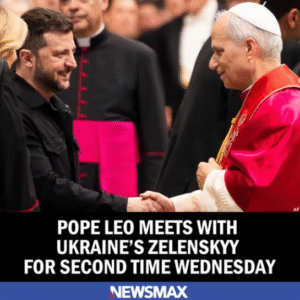Pope Leo XIV met with Ukrainian President Volodymyr Zelenskyy on Wednesday for the second time, in a high-profile effort to promote peace amid the ongoing war between Ukraine and Russia. The meeting took place at Castel Gandolfo, the Pope’s summer residence near Rome, and focused on diplomatic solutions, humanitarian concerns, and the possibility of the Vatican hosting future peace negotiations.
During their private talks, Pope Leo reaffirmed the Vatican’s readiness to serve as a neutral platform for potential peace discussions between Ukraine and Russia. Zelenskyy welcomed the offer, expressing appreciation for the Vatican’s consistent support for Ukraine and its moral authority in global affairs. He emphasized Ukraine’s desire for a just and lasting peace, noting that any negotiation must be based on Ukraine’s sovereignty and territorial integrity.
The meeting comes at a critical moment as the war, now in its third year, continues to inflict severe human and economic damage on Ukraine. Zelenskyy and Pope Leo discussed the fate of thousands of Ukrainian children who were reportedly deported to Russia since the beginning of the war. The Ukrainian president thanked the Vatican for its role in mediating humanitarian efforts and helping to reunite some of the children with their families. The Pope expressed deep concern for the ongoing suffering of civilians, especially vulnerable populations such as children, the elderly, and displaced families.
Zelenskyy also raised the issue of Ukrainian prisoners of war, urging the Vatican to use its influence to press for broader prisoner exchanges and humanitarian access to occupied territories. Pope Leo reiterated his commitment to supporting humanitarian missions and encouraging international cooperation to protect human rights during wartime.
In addition to discussing wartime concerns, the leaders also spoke about post-war recovery. Zelenskyy highlighted Ukraine’s need for international support to rebuild infrastructure, schools, hospitals, and communities destroyed by Russian attacks. He shared plans related to the upcoming Ukraine Recovery Conference, scheduled to take place in Rome, where global leaders will discuss long-term reconstruction strategies. Pope Leo voiced support for these efforts and called for global solidarity in helping Ukraine recover and heal.
The meeting builds on the relationship established during their first encounter in May, shortly after Pope Leo assumed the papacy. Since then, the Pope has taken a more active role in global diplomacy, especially in conflict zones. His outreach to both Kyiv and Moscow is part of a broader vision to position the Vatican as a moral and neutral mediator in international disputes. While Moscow has so far declined Vatican offers to host peace talks, Pope Leo has continued to advocate for dialogue and nonviolent solutions.
The Pope’s efforts have not gone unnoticed. Global observers see his involvement as a potential bridge between Eastern and Western powers, especially in a conflict where traditional diplomatic channels have stalled. His ability to engage on both humanitarian and spiritual levels adds weight to his proposals, even if immediate political outcomes remain uncertain.
Despite the Pope’s peace efforts, the situation on the ground in Ukraine remains volatile. Russian military operations continue in eastern Ukraine, with recent reports of airstrikes and shelling in civilian areas. Ukrainian forces, meanwhile, remain engaged in defensive operations and continue to receive military aid from Western allies. The ongoing violence underscores the difficulty of achieving a ceasefire, much less a comprehensive peace agreement.
Still, the Vatican’s involvement brings a new dimension to the search for peace. As a respected moral authority with no direct political stake in the conflict, the Pope may be able to encourage reluctant parties to consider dialogue, even if indirectly. His emphasis on compassion, reconciliation, and human dignity could serve as a foundation for future discussions.
Zelenskyy’s visit to the Pope also serves a symbolic purpose. It demonstrates Ukraine’s commitment to peace and diplomacy while reaffirming its alignment with global humanitarian values. For the Ukrainian people, the meeting is a sign that their suffering is being recognized on the world stage, and that efforts toward peace are ongoing—even amid daily hardship.
While the road to peace remains long and uncertain, the second meeting between Pope Leo and President Zelenskyy marks an important moment in the broader diplomatic landscape. It shows that moral and spiritual leadership continues to play a role in modern geopolitics, and that dialogue, even during war, remains a crucial tool for change.
In the coming weeks, attention will likely turn to how Moscow responds to renewed Vatican overtures and whether any conditions might emerge that allow for talks to begin. Meanwhile, humanitarian efforts will continue, with the Vatican expected to play a role in future initiatives focused on displaced families, civilian protection, and rebuilding Ukraine’s devastated regions.
The Pope ended the meeting by offering prayers for the Ukrainian people and calling for peace not only in Eastern Europe but around the world. President Zelenskyy expressed gratitude for the Pope’s ongoing support and reaffirmed his willingness to continue working with the Vatican and other partners to secure a peaceful, sovereign future for Ukraine.


